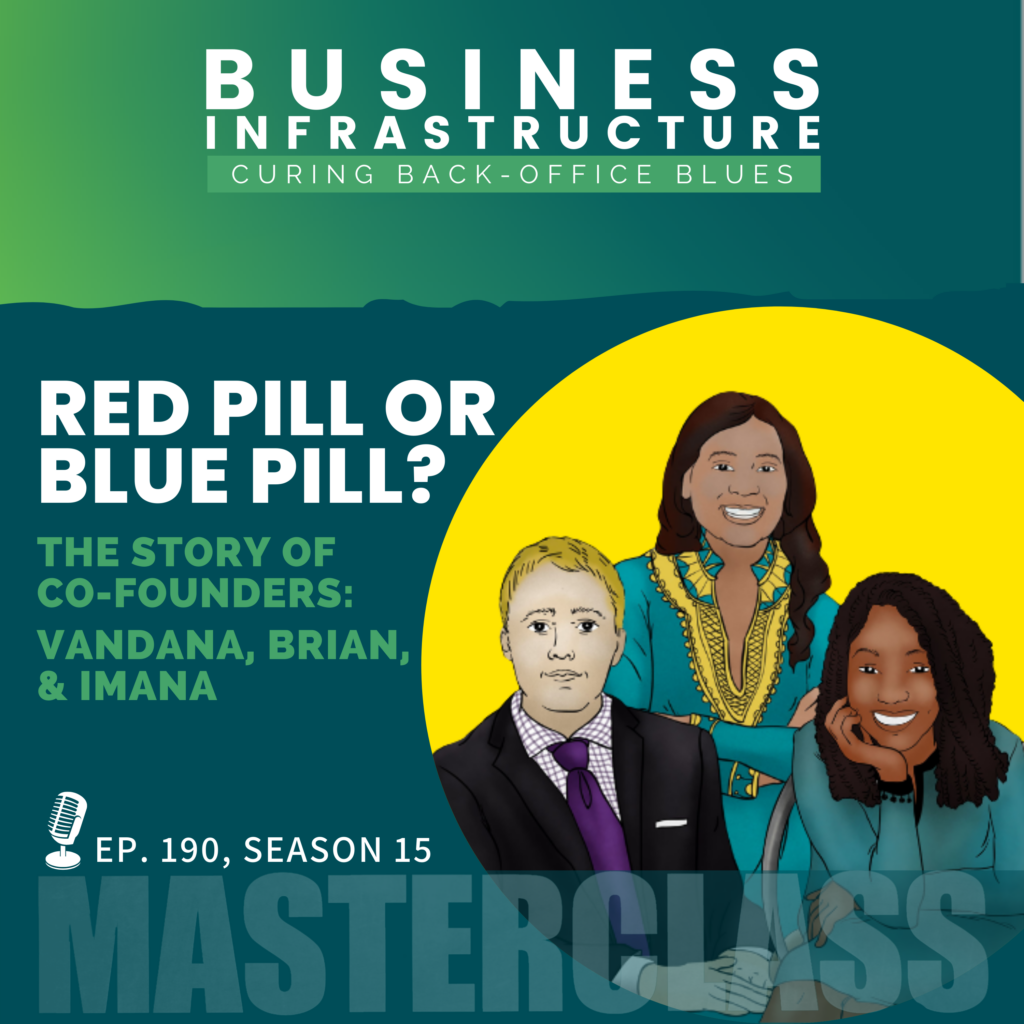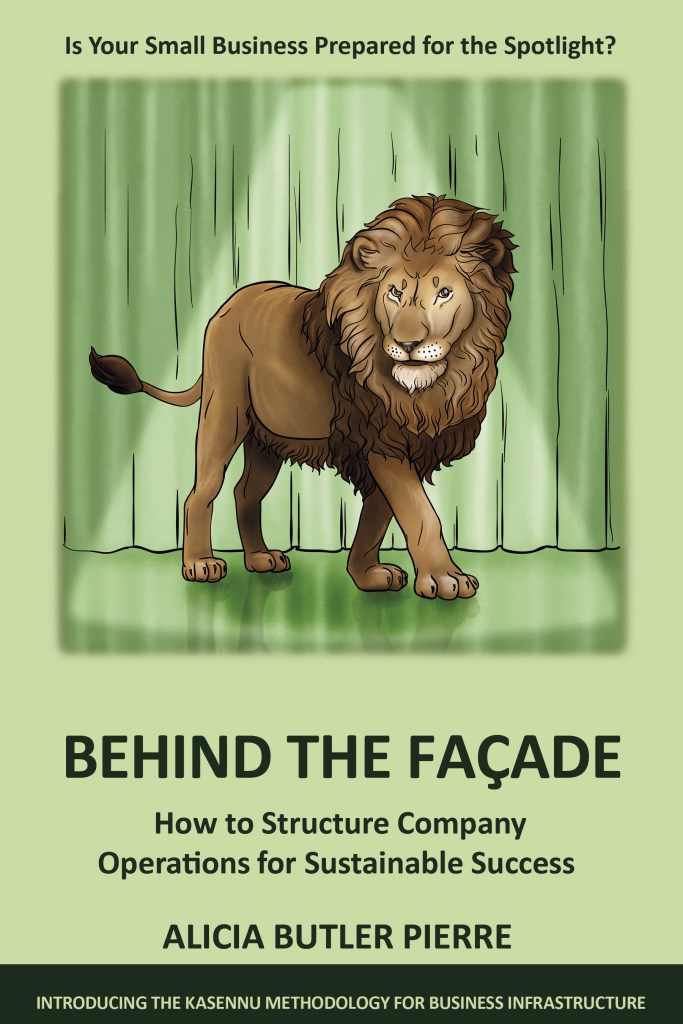Transcript
It’s hard to believe, but we’re at the halfway point of our first-ever audio masterclass for business infrastructure. At this point, you’ve heard four sets of stories and how-to lessons for building business infrastructure to stabilize fast growth and scale sustainably.
If you haven’t listened to those episodes, then you’re missing out! They’re like building blocks for understanding this next story.
Vandana is not only in business with her best friend, but her husband too. Demand for their mortgage company is skyrocketing thanks to their recurring role on a new reality TV show. The spotlight isn’t just exposing their talents, but their operational vulnerabilities too. Will their conflicting objectives lead them to make the right decisions?
This is episode 190. Red Pill or Blue Pill? The Story of Vandana Thiagarajan and a Mortgage Company’s Meteoric Rise.
____________________________________
Vandana Thiagarajan, her husband Brian, and her best friend, Imana, are co-founders of a fast-growing mortgage company in Brooklyn, New York. In just three years, they managed to secure a recurring role on a new reality TV show featuring first-time homebuyers in the Big Apple. This show is responsible for their most recent wave of growth. But with that growth has come the inability to meet their loan processing time.
Each co-founder is now at an impasse, especially Vandana, as they each decide whether to pursue their original dreams or continue down their current path. The stakes are high. All eyes are on them. Their consultant introduces them to the Service Delivery Blueprint element of the Kasennu framework to help them make the right decision.
_____________________________________
[Director]: “And…cut!”
An energetic director yelled into his megaphone as the second assistant camera clapped the top layer of the clapperboard to the bottom, making a loud, clicking noise. This was the sixth, and final, take of a particular scene on a new real estate reality TV show where a young and very impressionable couple were interacting with a savvy mortgage broker to negotiate the terms of their first home loan.
That mortgage broker happened to be Vandana Thiagarajan. She was exhausted from having been on the set since 6:00 am. It was now getting close to noon and her stomach was practically tied into knots from hunger pain. Although there was plenty of food around, Vandana wanted to be away from the set more than anything else. Before she stood up from the desk on the show’s set, she couldn’t help but think about the pain the illusion of this TV show was causing her.
The entire set was staged. The only similarity to their actual office was the prominent use of turquoise in the set’s décor. In reality, she operated out of the second floor of a narrow brownstone in Brooklyn, not this fancy Manhattan office encased in glass with a view of the Hudson River.
[Vandana]: “All the world’s a stage, and all the men and women merely players: they have their exits and their entrances…”
Vandana retrieved her phone from her suit pocket. Her voicemail was full, a recurring blessing and curse. A blessing because it was an indication that her company’s services were in high demand. A curse because they were struggling to meet that demand. Soon, Hunter Jeffries, the consultant she and her partners had been working with for close to two months, walked up to her.
[Hunter]: “Vandana, that was awesome! You’re a natural on camera!”
[Vandana]: “Thanks, Hunter.”
Vandana managed to force a smile. She was getting used to masking truth. By most accounts, she should be happy. At 33-years-old, she was co-owner of a fast-growing residential mortgage company in New York City, arguably one of the highest valued real estate markets in the world.
Yet, Vandana felt trapped. As she continued reflecting on the pressures of performing both on and off camera, she found her breathing becoming more laborious. She removed her purse from the desk she sat behind on the set, fumbling through it looking for her inhaler. The last thing she needed was to have an asthma attack.
Hunter was curious about Brian and Imana’s whereabouts. Brian Miller was Vandana’s husband of four years, and Imana Van Dijk was her best friend of 24 years. In an attempt to divert attention from the obvious, Vandana fibbed and said they were both at the office working. She needed to change the subject.
[Vandana]: “Hey, don’t you have a train to catch?”
[Hunter]: “Yeah, I guess it’s getting to be about that time, eh?”
Hunter was scheduled to take a train into Boston for another client appointment before crossing the Canadian border into Toronto.
Hunter was soon back on the TV show’s set at Vandana’s request. She was on the set again without her business partners – Brian would be busy at the law firm where he worked full-time, and that Imana would be visiting family in their native Suriname. It was the perfect time to candidly speak with Hunter, one-on-one.
After completing filming for the day, Vandana and Hunter began walking toward the nearest subway station. Vandana continued to make small talk with Hunter. She started by reiterating what Hunter already knew: the TV show was becoming more popular and more people were requesting their services as a result.
[Hunter]: “Is everything okay, Vandana? It seems like you’re hiding something. I realize being on a crowded train isn’t the best place to have this conversation, but I can’t shake the feeling that you’re withholding information. What’s up?”
[Vandana]: “Honestly, Hunter, I don’t know where to begin. I…I…ugh! How can I say this delicately?”
[Hunter]: “Don’t worry about being delicate.”
[Vandana]: “We’re in trouble.”
[Hunter]: “That’s why you hired me, remember? To help you get a business infrastructure in place to make sure your growth is sustainable and replicable.”
[Vandana]: “Yes, I know Hunter, but there’s some stuff I don’t think Brian told you.”
Hunter leaned in closer toward Vandana so that she could speak into his ear without others on the train hearing her.
[Vandana]: “We can’t meet the loan processing timeline we’ve promoted for the past year. The show is doing well and that’s why we’ve been asked to participate in a second season, but it’s shining a spotlight on our weaknesses. Right before we started taping this season, a local investigative news reporter interviewed several couples who participated on the show last season. They reported shoddy contractor work and had proof to back their accusations.”
[Vandana]: “Of course, this made us guilty by association, even though we have nothing to do with the contractors on the show. That’s when Brian reached out to you as a proactive measure. Don’t get me wrong, I’m grateful for what you’ve helped us with so far, but now our clients are starting to complain more and more about the time it takes to process their loan applications.”
[Vandana]: “One client even accused us of ‘going Hollywood’ and not making time for people unless it involves TV. If we’re not careful, these angry clients can also call an investigative reporter to expose us directly. If we don’t fix this soon, we’ll lose endorsements, not to mention the opportunity to be on this show and others in the future.”
Hunter straightened up in his seat. When he looked at Vandana, her eyes were welling with tears.
[Vandana]: “Hunter, I feel like I’m caught up in the Matrix! I know how valuable the TV show is in getting us exposure, but I also know how important it is to remain loyal to our customer base and referral network we had before the TV fame. Have you seen that movie, The Matrix?”
[Hunter]: “Yes, I have.”
[Vandana]: “It’s like I’m Neo and you’re Morpheus. Through your work, you’ve presented me with the option to choose between taking the red pill and the blue pill. If I take the red pill, I’ll see how deep this Hollywood rabbit hole takes me, while risking the possibility of losing myself and my vision for our company in the process. The fame will become my drug of choice and I might develop an insatiable appetite for it. And we’ll continue the illusion that all is well as long as the money continues to flow in.”
[Vandana]: “On the other hand, if I take the blue pill, I can continue down the original path of operating a business in the real world, as we originally planned. It might take longer for us to achieve some of our goals, but at least we’d be able to keep our promises and not risk being accused of fraud. It’s all smoke and mirrors!”
At that moment, they arrived at Penn Station. As they walked through the crowded corridor to the platform where Hunter would catch his next train, they found a less crowded place to sit. He had about 30 minutes before boarding.
[Hunter]: “What do you mean when you say, ‘it’s all smoke and mirrors’?”
[Vandana]: “This TV show has been great for business. But we’re mortgage brokers, not actors! I feel like we’re getting further and further away from our original vision, which was to help prevent displacement of long-time residents in areas undergoing gentrification. We envisioned partnering with urban planners and eventually branching into real estate development.”
[Vandana]: “Instead, Brian is off hob-knobbing and rubbing elbows with the Who’s Who of New York, trying to secure a future partnership at the real estate law firm where he works. And Imana is on a high from all of the newfound fame. She’s always traveling between here, Miami and Paramaribo. I’m tired of making compromises.”
[Vandana]: “When we started the company three years ago, we each brought something unique and valuable to the table. Brian came with the knowledge of real estate law, Imana came with the knowledge of urban and smart city planning, and I came with the financial acumen to structure deals for our clients.
[Vandana]: “Now, instead of us balancing each other out, I feel caught in between my husband and my best friend. It’s maddening!”
This intrigued Hunter. After working with them over the past two months, he thought he knew their backstory. But he realized he mostly spent his time talking to Brian and not Vandana or Imana for that matter. He knew that Brian’s father was also a real estate attorney and that Brian wanted to follow in his footsteps.
[Hunter]: “Are you referring to Brian’s law practice? Is that what’s troubling you?”
[Vandana]: “That’s part of the problem. Did you know that Brian wants to make partner at his firm? If he does, then where would that leave Imana and me?”
In all his conversations with Brian, that subject also never came up. He could understand why this would upset Vandana. There was no way she and Imana could keep up with the volume of business without Brian’s full participation.
[Hunter]: “But that’s why we’re working together, remember? We’ve already established the tasks to perform and identified who will perform those tasks during the Business Parts Analysis exercise. Now, we just need to identify and document your processes so that, as you hire additional employees, they’ll know exactly what to do. And soon, you’ll be able to meet your targeted loan processing timeline again.”
[Hunter]: “When does Imana return?”
[Vandana]: “Next week.”
[Hunter]: “Ok, now that I’ve seen what you do on set, I’ll draft a summary of the next thing we previously agreed to work on, a Service Delivery Blueprint. This will help get you all back on track. We can talk about the TV thing later but, for now, consider this. If you look at the TV show as a marketing and business development tool and not as a time-wasting distraction, you might develop a new appreciation for it. You might be able to use the Matrix to your advantage.”
[Hunter]: “For now, it’s causing you pain because you’re shouldering most of the responsibility. A lot of the time is spent in multiple takes while on the set and it causes you anxiety because you’re thinking of all the work that has to be done, the phone calls to return, the loan applications to process, etcetera. The sooner we outline your delivery process, the sooner you’ll sleep better.”
[Vandana]: “I hear you. But it’s more than just worrying about the volume of work required to keep up. It’s also about salvaging and protecting our reputation and brand at all costs!”
It was five minutes before boarding time. Hunter thanked Vandana again for the information and dashed onto the platform to board his train. Meanwhile, Vandana decided to walk outside of Penn Station and onto the street headed south. Despite the snow and biting wind ripping around the corners of the skyscrapers, she needed some fresh air. She walked long enough to stop by a street vendor to order a veggie sandwich.
She hopped back onto a subway train at 28th street and caught the Red Line down to Chambers Street where she again walked outside, this time to Battery Park. She needed more time to think and liked being able to take in the wonderment of the Financial District. Seeing the New York Stock Exchange, the Statue of Liberty and all the streets with Dutch names always kept her grounded as she reflected on her business’ mission.
Though she donned a thick wool scarf, heavy down coat and fur-lined hat and gloves, none proved sufficient to combat the raging winds blowing off the Hudson River. She thought about walking across the Brooklyn Bridge, but the wind gusts were too punishing. Instead, she took the subway to Brooklyn and headed to the place she called home, a three-story brownstone she and Brian shared with Imana in the famous Bedford Stuyvesant neighborhood.
As she walked toward home, she reflected on how much the neighborhood had changed in the 15 years she’s lived in New York. There was no doubt about it, Brooklyn was being gentrified. They were fortunate to have purchased their brownstone right before the most recent price swell. Though she had no regrets living here, she still couldn’t believe she and Imana traded living in a tropical paradise for a concrete jungle.
Imana lived on the top floor of their brownstone while Vandana and Brian occupied the main floor. The second floor was reserved for their office space and afforded them three rooms which they converted into a shared conference room and two separate offices. They rented out the basement. Looking around, Vandana noticed they were running out of space.
When Brian came home later that evening, Vandana decided to tell him about her conversation with Hunter.
****
Hunter wasn’t surprised when he received a phone call from Brian on a late Thursday night. But he was caught off guard when Brian told him that Vandana shared the details of the conversation she and Hunter had.
[Brian]: “I feel bad for putting my wife under all of this stress and strain. I got so absorbed in my legal world that I lost sight of the impact it had on her and on Imana, too, for that matter. She told me about the whole red pill/blue pill thing. Ironically, I feel the same way. I have to choose between continuing to work full-time at the firm versus our mortgage company. How soon can we start working on our Service Delivery Blueprint?”
[Hunter]: “We can start as soon as all of you can be together at one time.”
[Brian]: “Good. Imana flew in earlier this afternoon. I’ll ask them about the show’s schedule and their availability. Hopefully, we’ll have an answer for you by tomorrow.”
[Hunter]: “Sounds good. In the meantime, expect to receive an email from me explaining the Service Delivery Blueprint.”
By the time Brian was on the train to go to work the following Friday morning, Hunter sent the email he promised. Based on a quick scan, Brian was pleased to know that this effort would not be as tedious for them as the Business Parts Analysis. He sent a group text to Vandana and Imana asking them to check their email.
Imana’s phone beeped to alert her of a new text message. She opened her inbox to locate the email from Hunter. The details were spelled out in the body of it:
In your Service Delivery Blueprint, we will document the steps in delivering your core service, making sure to incorporate all staff identified in the Business Parts Analysis as well as the tools used to facilitate the client experience. We will also capture the metrics to monitor the client experience.
The next couple of paragraphs went on to detail the work they would do to accomplish this, as well as the value. Imana read on to the last paragraph…
There’s no need to take the red or the blue pill. You shouldn’t have to take a pill at all, as I believe there’s a win-win solution for everyone. We can start as soon as possible. Your full participation is necessary to ensure success. This work can be completed in as little as four sessions, both in-person and remotely, over a three-week period.
Imana began to text her response…
[Imana]: “Saw Hunter’s email. Sounds good. What does he mean by red pill and blue pill?”
Vandana replied to the text saying she would explain on their way to the set. They agreed they would call Hunter when they all returned home later that day, though they weren’t exactly sure what time that would be.
****
The next day, on an early Saturday morning, they called Hunter. Hunter asked if they had any questions about the Service Delivery Blueprint. Brian asked for confirmation on the actual steps they would take.
[Hunter]: “The primary purpose is to document the overall process of your company’s core business and to demonstrate how this core business functions in relation to all previously identified resources and support departments. This interconnectivity can be essential in building team camaraderie and securing your competitive advantage in quick loan processing. Remember, we identified your company’s departments as follows: General Management, Administration, Compliance, Operations, and Marketing & Sales.
[Hunter]: “Out of these departments, the Operations Department represents the core of your business. So, your Service Delivery Blueprint will capture the steps in fulfilling the work of the Operations Department from A to Zed.”
[Imana]: “Zed?”
[Hunter]: “Sorry, that’s how we say ‘Z’ in Canada. Welcome back, Imana! How was your trip?”
[Imana]: “It was good, Hunter, thank you! Guess what? I actually saw an episode from the first season of the show while I was in Suriname! Vandana and I are like superstars over there! I received a reception at home fit for a queen! I can’t wait to finish taping the second season.”
Unlike Vandana, Imana actually liked performing and treasured the celebrity status it brought to their business. But even she could appreciate the toll that the show was taking on Vandana. With Imana’s travel schedule and Brian’s full-time job, Vandana bore the brunt of running the business while simultaneously filming. After a moment of awkward silence on the phone, Hunter resumed talking.
[Hunter]: “That’s wonderful, Imana! It’s also a great segue into how I think you will be able to use the Service Delivery Blueprint. I’ll give you more insights to better manage the deluge of business because of the show. For example, I took a closer look at your website and realized that you all only communicate how fast you can process a loan without providing details on your actual process. Do you find yourselves constantly answering the same questions about your loan process?”
[Vandana]: “Yes! It’s tiring constantly repeating the same thing over and over.”
[Hunter]: “Precisely my point. After we document your Service Delivery process, you’ll be able to summarize it and include it on the website, along with a Frequently Asked Questions page that you can direct clients to in the future. The more information you provide your clients on the website upfront, the better informed they’ll be before they call you.”
[Brian]: “Can we start this weekend? It’s short notice, but would you be able to make the trip here tomorrow? I’ll pay for your flight.”
[Hunter]: “Thanks Brian, but that won’t be necessary. We can actually do the first session remotely. That’ll give me time to plan a trip to New York for the second session. Sounds good?”
[Vandana]: “Sounds perfect!”
[Hunter]: “We need to get you all to a place where your operations matches your company’s façade. I think this is what’s really at the heart of what bothers Vandana. I’m just as committed to fixing this as you all are. I’ll talk to you all tomorrow morning.”
So…what does Hunter mean when he mentions having your operations match your façade? Well, the best way to find out is in my book, Behind the Façade: How to Structure Company Operations for Sustainable Success. I’m Alicia Butler Pierre and I wrote this book specifically for you – the owner or manager of a fast-growing small business. Discover how you can build business infrastructure as well as a Service Delivery Blueprint to scale without chaos. Get your copy today on Amazon or wherever books are sold online. Click the link in this episode’s description to buy your copy today!
On February 1, 2015, the first Sunday of the month, Vandana and Imana eagerly dialed into a conference call with Hunter. Brian, they told Hunter, wouldn’t be able to participate due to an emergency meeting at his job.
[Hunter]: “Before we start, I want to set expectations for today’s call. As a reminder, the goal for today’s call is to document every step, from beginning to end, for delivering your core mortgage services to your clients. This call is recorded, so don’t worry about having to stop along the way so that I can catch up with my typing.“
[Hunter]: “As you both talk, I may ask you questions if I believe there are details or steps missing. Who wants to start?”
Vandana indicated she would start.
[Vandana]: “When prospective clients come to us, we must pre-qualify them for a loan before we enter their information into our loan processing algorithm. Then, we…”
[Hunter]: “Wait, I need to stop you, Vandana. You didn’t do or say anything wrong, but I want you and Imana to go further upstream into your Service Delivery process.”
[Imana]: “What do you mean?”
[Hunter]: “We need to start with how these prospective clients find out about your business in the first place. In other words, what sales and business development activities take place and by whom?”
[Vandana]: “Oooh…we really will cover everything from A to Z! A lot of that is in Brian’s domain. It’s part of our strategy execution.”
[Imana]: “Yeah Vandana, but we have a general idea of what he does. I think Hunter just wants us to get much of our knowledge out of our heads and onto paper so that we can collectively review and determine where information may be missing.”
Now that Vandana and Imana were clearer on where to begin describing their Service Delivery process, they told Hunter that they constantly work to form new, and maintain existing, strategic alliances and partnerships.
As they continued talking, Hunter noted any references they made to forms, templates, software, or checklists. Two hours later, with Hunter’s guidance, Vandana and Imana described the process from the moment prospective borrowers are referred to them all the way to when borrowers are approved for a loan and close on their homes.
Hunter told them he documented a total of 65 steps and that he would email a draft once he had a chance to analyze those steps and ask more questions. It’d also be important for Brian to have the chance to review the steps prior to the next session.
****
As planned, Hunter flew into LaGuardia Airport the following week and took a cab into the city on a late Friday afternoon, ultimately settling in a hotel room in iconic Times Square. He was always energized by the flashing lights and the hustle and bustle of the city known for never sleeping.
By 9:00 am on Saturday, he found himself ringing the doorbell at the brownstone that Brian, Vandana, and Imana called home as well as their place of business. Brian greeted Hunter at the door, welcomed him inside, and, after a few minutes of small talk, led him up the intricately carved wooden staircase to the second floor.
Their conference room was a former bedroom and just as Hunter remembered from the last time he was there – a soothing blend and balance of traditional architecture with contemporary furnishings. Three of the walls had exposed brick while the fourth was a plastered wall painted in a bright turquoise that commanded attention. The walls were a nice accent against the pine hardwood floors and the high ceiling was complemented by some of the most ornate crown molding Hunter had ever seen. This should be the location where they film!
Vandana and Imana were already seated at the table in the conference room.
[Hunter]: “Good morning!”
[Imana]: “Hey, Hunter! How are you?”
[Vandana]: “Hunter! You’re back! We haven’t managed to scare you off yet?”
[Hunter]: “Nope. I’m still here. Are you all ready?”
[Brian]: “Yeah man, let’s do this! What do you want to tackle first?”
[Hunter]: “Were you able to review the questions I added to the Service Delivery Blueprint draft?”
[Vandana]: “We sure did!”
Vandana handed Hunter a printed copy of the document that included answers to all of his questions. Immediately, he noticed that the number of steps he originally captured had gone from 65 to 86. In answering his questions, they added 21 new steps.
[Hunter]: “Wow! Look at this! This is awesome! Great job! What I’d like to do now is use this printed version and literally walk through every step, to the best extent possible.”
Hunter opened the business infrastructure software installed on his laptop and imported Vandana’s version of the document.
Then, he began fact-checking the process, as documented. This involved making sure the flow of the information was correct and didn’t exclude any important steps. Hunter used the business infrastructure software to record the name of the role performing each step into the far left margin, as well as the name of any tool used into the far right margin.
As Hunter predicted, this exercise took about four hours. He explained that, during their half-day session tomorrow, they would segment the steps into stages.
[Hunter]: “The purpose for segmenting the steps is two-fold. One, these are the stages that can be used to communicate your service delivery process externally to your customers without revealing confidential information. Two, these stages will be used to populate a Service Delivery Matrix which will serve as an internal document to share with your staff. This will be especially critical since the bulk of your staff works remotely.”
[Vandana]: “Oh no! A matrix Hunter? You’re going to create a Matrix? I told you, I’m trying to get out of the Matrix!”
[Hunter]: “My apologies, Vandana. We can call it whatever you like. Let me show you what it will look like.”
They all gathered around Hunter and his laptop. On the screen was what appeared to be a blank grid.
[Hunter]: “The first row will showcase the stages we will identify tomorrow. The second row will display the staff needed to execute the steps assigned to each stage. The third row lists the tools needed to perform the steps assigned to each stage. The fourth row summarizes the steps involved in each stage of the overall process. And finally, the last row is for metrics to monitor in each stage.”
Vandana liked what she was hearing. This was exactly what she’d been waiting for since they began working with Hunter. She, Brian, and Imana would finally all be on the same page regarding the order in which things needed to happen. This would help them pinpoint when and where breakdowns occurred in their process. She could see how this format for the process was different from a flowchart or a standard operating procedure. This matrix format provided a high-level, one-page summary with just enough detail to understand their overall value chain – a fitting revelation to mark the conclusion of this session.
****
The next day, Vandana and Imana were in the kitchen on the main floor of the house when Hunter arrived. They offered him a cup of coffee which he gladly accepted. Several minutes later, they all walked up to the second floor to begin the work for the day – segmenting the 86 steps of their process into stages.
[Vandana]: “Hunter, we talked a little more after you left yesterday about this uh, matrix. We decided we should call it what it is: a blueprint, a Service Delivery Blueprint that provides direction for how we deliver value to our customers and keep our promises to ensure a consistent and positive experience.”
[Hunter]: “I like that! Why don’t we get started?”
Hunter requested Vandana print four copies of the process. Hunter guided them through the segmentation of the 86 steps into stages. He explained that they should not create more than nine stages for simplicity as well as memory recall and retention.
He began to talk through the steps of their process and noted that the first few steps had to do with networking, and building and nurturing relationships with their strategic alliances and partnerships. He challenged them to think about where the division occurred from when a potential client is referred to them to the point where they make initial contact with that potential client. Brian confirmed that this division occurred around step nine of the process, where the potential borrower’s contact information is entered into their database and an email is sent to establish a date and time to conduct a borrowing interview.
At this point, their Service Delivery Blueprint matrix contained a completed first row of stages. Hunter said he would use his previous notes to fill in the rest of the matrix with the tools and resources to assign per stage. Before he left, he pointed out the very last row of the blueprint would contain the metrics to use in monitoring the performance of each stage.
He emphasized that this row of metrics would highlight the location of process bottlenecks. Being a number cruncher, Vandana wanted to spend the remainder of the week thinking through these metrics.
Hunter also encouraged them to start thinking about which stages they wanted to share with their customers. That’s the information they could begin adding to their marketing collateral, including their website.
****
Later that week, Brian called Hunter to confirm a date and time to meet for their final session. He emailed Hunter a copy of the updates they made to the Service Delivery Blueprint, which included a completed row of information for metrics. They agreed to talk on Sunday via a remote session where Hunter could share his computer screen.
During their remote session, Vandana could hardly contain her excitement. As a statistician, talking about metrics was like music to her ears.
Once everyone confirmed that they could see Hunter’s screen, Vandana began explaining the metrics for each the seven stages of their process. Combined, these metrics equaled 33 days. This is the amount of time it should take them to complete the entire process.
Vandana also mentioned that they would only communicate a five-stage process to their clients. In other words, only five of the seven stages would be shared publicly on their website. Those are the stages where they would track the total time to pre-qualify, price, select, process, and close a loan.
[Vandana]: “We’ve determined the exact points at which we will begin tracking the loan processing timeline. Once we’ve collected at least a month of data, I can start conducting an analysis to determine root causes of not meeting the 33-day goal. At that point, we can keep tweaking our process until we reach a point where we consistently meet or outperform that goal 99% of the time.”
[Hunter]: “Vandana, I’m very impressed! You’re clearly more versed on process improvement than I am. I can tell you put a lot of thought into this and I’m so proud!”
[Brian]: “That’s why I married her!”
Imana went on to explain the metric for the last stage, Post-Closing.
Hunter asked them to describe those nine steps as a stage. He suggested they refer to the stage as Lead Generation but Brian suggested they call it Prospecting instead. Hunter entered the first stage of their process as Prospecting in his business infrastructure software. He then specified that this stage included steps one through nine of the process.
[Imana]: “We’re going to implement a client feedback survey. What’s crazy is that this is something we used to give all the time in our first year in business. I strongly believe that if we had continued issuing and collecting feedback surveys, we could have gotten ahead of the recent rash of complaints. I’ll be the first to take the blame for this. With my travel schedule, I became lax on some of these small, but critical details that make for an overall great client experience.”
[Imana]: “So we’ve decided that, starting tomorrow, we’ll resume tracking this metric. Anything less than a five-star overall rating is unacceptable and will warrant immediate investigation.”
[Hunter]: “Well, this is a first for me. You all have left me speechless. Again, I’m impressed with all the hard work and effort you’ve put into this.”
[Imana]: “It’s amazing what a little bad press can do for you, huh?”
[Hunter]: “No kidding! Well guys, I look forward to speaking with you again in another month when you’ve collected more data and tested your Service Delivery Blueprint. Until then, I want to remind you to sign up for that process workshop coming up in Atlanta, Georgia. At this point, I don’t think we need to make a case for the importance of documenting processes.”
Hunter determined a date in March when they could meet again. By the time the remote session ended, Vandana had already signed them up for the process workshop in Atlanta.
A month later, in mid-March 2015, Hunter called Brian, Vandana and Imana on three-way. They eagerly shared their accomplishments over the past month. By now, they finished taping episodes for the second season of their show and were each committed to nailing down the right Service Delivery process before the show aired.
Vandana reported discovering more areas where they could automate their process to streamline their operations and improve the overall client experience.
Imana announced she found an affordable commercial office suite to house all three of them as well as two additional offices and a conference room. She and Brian would sign the lease soon.
It was then that Hunter reminded all of them about the process workshop they’d attend next month. Imana might be able to use some of the processes from this workshop to train a new receptionist they planned to hire.
[Hunter]: “In fact, you’ll learn how to identify and document processes and store them in a digital operations manual that you can use to train all of your existing and future employees.”
[Hunter]: “I love everything you’ve done and are in the process of implementing! Before we wrap up, does anyone have any questions?”
[Vandana]: “Yeah…I do. Red pill or blue pill?”
[Hunter]: “Ha! I should be asking you that!”
[Vandana]: “Well, it turns out you were right. I don’t need to take either pill. I can choose not to choose and just be. By changing my perception I can change my reality altogether.”
[Hunter]: “Yep! I know how much you like Shakespeare. Didn’t he write, ‘To be or not to be, that’s the question?’”
Vandana laughed out loud. She hadn’t made that connection, but Hunter was right.
[Vandana]: “Yes! And that’s the question I really should have been asking all along.”
They ended their call with Hunter. But Vandana wasn’t the only one who had a revelation. Listening to the exchange between Vandana and Hunter gave Brian no choice but to reveal a secret he’d been keeping. He asked that Vandana and Imana join him in the kitchen.
[Brian]: “Please, sit down. [NERVOUS] There’s something I need to tell you.”
He then resumed with step 10 of the process and, similar to how he helped the team figure out the first stage, he helped them identify the second stage as Pre-Qualification. They repeated this stage identification exercise until all steps of the process were segmented into seven distinct stages: Prospecting, Pre-Qualification, Pricing, Loan Selection, Loan Approval & Processing, Closing, and Post-Closing.
****
Thank you for listening. If you enjoyed this episode, then leave a five-star rating and a review to let us know what you liked best. Be sure to subscribe wherever you’re listening to this podcast so that you won’t miss the next episode!
That’s when I’ll reveal the exact steps for creating a Service Delivery Blueprint for your organization. And yes, this applies if you sell products too!
The story you just heard is based on Chapter 6 of the book, Behind the Façade: How to Structure Company Operations for Sustainable Success. A link is available in this episode’s description wherever you’re listening.
A special thank you to Equilibria, Inc. for making this masterclass possible.
This episode was written, produced, and narrated by me, Alicia Butler Pierre. Audio editing by Olanrewaju Adeyemo. Voice acting by Dominique Van Dijk, Frank Jones, and Kamaria Goggins. Original score and sound design by Clarence Levy III with Sabor! Music Enterprises.
This is the Business Infrastructure – Curing Back-Office Blues podcast.









